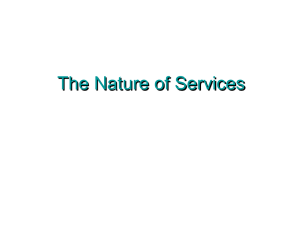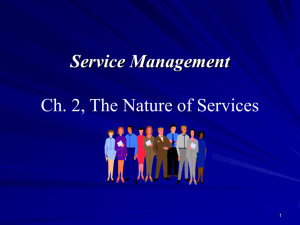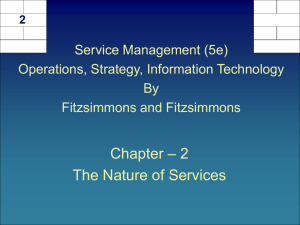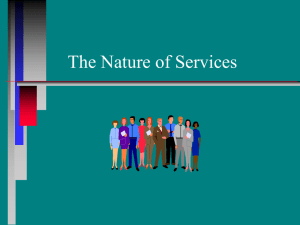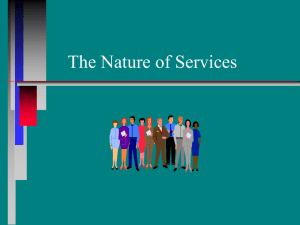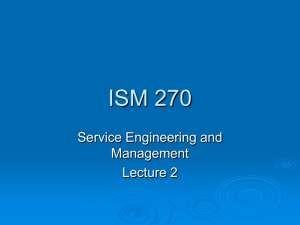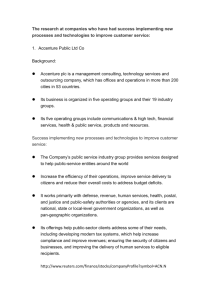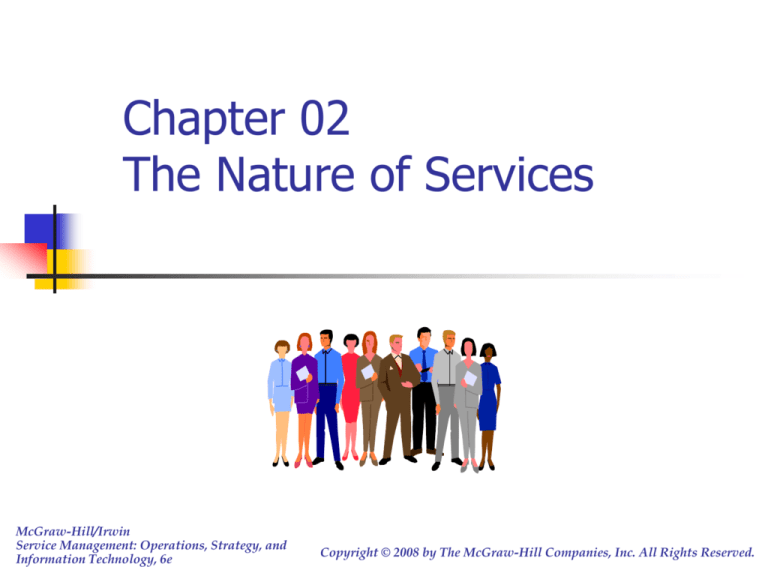
Chapter 02
The Nature of Services
McGraw-Hill/Irwin
Service Management: Operations, Strategy, and
Information Technology, 6e
Copyright © 2008 by The McGraw-Hill Companies, Inc. All Rights Reserved.
Learning Objectives
Explain what is meant by a service-product bundle.
Identity and critique the five distinctive characteristics of
a service operation and explain the implications for
managers.
Explain how services can be described as customers
renting resources.
Describe a service using the five dimensions of the
service package.
Use the service process matrix to classify a service.
Explain how a strategic classification of services can be
helpful to managers.
Explain the role of a service manager from an opensystems view of service.
2-2
Service-Product Bundle
Element
Business
Core
Peripheral
Goods
Peripheral
Service
Variant
Core Goods
Example
Custom clothier
Business suits
Core Service
Example
Business hotel
Room for the night
Garment bag
Bath robe
Deferred payment
plans
In house
restaurant
Coffee lounge
Airport shuttle
2-3
Distinctive Characteristics of Services
Simultaneity: opportunities for personal selling,
interaction creates customer perceptions of quality
Perishability: cannot inventory, opportunity loss of idle
capacity, need to match supply with demand
Intangibility: creative advertising, no patent protection,
importance of reputation
Heterogeneity: customer involvement in delivery
process results in variability
Customer Participation in the Service Process:
attention to facility design, opportunities for coproduction, concern for customer and employee behavior
2-4
Major differences bet. service
and manufacturing companies
Management
Quality
Productivity/Cost
Non-ownership Classification
of Services
Type of Service
Customer value
Examples
Management Challenge
Goods rental
Obtain temporary right to
exclusive use
Vehicles, tools, furniture,
equipment
Site selection and
maintenance
Place and space
rental
Obtain exclusive use of
defined portion of a
larger space
Hotel room, seat on
airplane, storage unit
Housekeeping and
achieving economies
of scale
Labor and
expertise
Hire other people to do a
job
Car repair, surgery,
management
consulting
Expertise is a renewable
resource, but time is
perishable
Physical facility
usage
Gain admission to a
facility for a period
of time
Theme park, camp
ground, physical
fitness gym
Queuing and crowd control
Network usage
Gain access to participate
Electric utility, cell phone,
internet
Availability and pricing
decisions
2-6
Implications of Rental/Usage Paradigm
Creates the option of renting a good upon
demand rather than purchase.
Service often involves selling slices of larger
physical entities.
Labor and expertise are renewable
resources.
Time plays a central role in most services.
Service pricing should vary with time and
availability.
2-7
The Service Package
Supporting Facility: The physical resources that
must be in place before a service can be sold.
Examples are golf course, ski lift, hospital, airplane.
Facilitating Goods: The material consumed by the
buyer or items provided by the consumer. Examples
are food items, legal documents, golf clubs, medical
history.
Information: Operations data or information that is
provided by the customer to enable efficient and
customized service. Examples are patient medical
records, seats available on a flight, customer
preferences, location of customer to dispatch a taxi.
2-8
The Service Package (cont.)
Explicit Services: Benefits readily observable by
the senses. The essential or intrinsic features.
Examples are quality of meal, attitude of the waiter,
on-time departure.
Implicit Services: Psychological benefits or
extrinsic features which the consumer may sense
only vaguely. Examples are privacy of loan office,
security of a well lighted parking lot.
2-9
The Service Process Matrix
Degree
of labor Intensity
Low
High
Degree of Interaction and Customization
Low
High
Service Factory
Service Shop
* Airlines
* Hospitals
* Trucking
* Auto repair
* Hotels
* Other repair services
* Resorts and recreation
Mass Service
* Retailing
* Wholesaling
* Schools
* Retail banking
Professional Service
* Doctors
* Lawyers
* Accountants
* Architects
2-10
Strategic Service Classification
(Nature of the Service Act)
Direct Recipient of the Service
Nature of
the Service Act
Tangible actions
People
People’s bodies:
Health care
Passenger transportation
Freight transportation
Repair and maintenance
Beauty salons
Exercise clinics
Restaurants
Veterinary care
Janitorial services
Laundry and dry cleaning
People’s minds:
Education
Intangible actions
Things
Physical possessions:
Broadcasting
Information services
Theaters
Museums
Intangible assets:
Banking
Legal services
Accounting
Securities
Insurance
2-11
Strategic Service Classification
(Relationship with Customers)
Type of Relationship between Service
Organization and Its Customers
Nature of
Service Delivery
“Membership” relationship
Insurance
Telephone subscription
Continuous delivery
of service
Discrete transactions
No formal relationship
Radio station
Police protection
Electric Utility
Lighthouse
Banking
Public Highway
Long-distance phone calls
Theater series tickets
Restaurant
Pay phone
Transit pass
Wholesale buying club
Airline frequent flyer
Toll highway
Movie theater
Public transportation
2-12
Strategic Service Classification
(Customization and Judgment)
Degree of Customization
Extent to Which Personnel
Exercise Judgment in
Meeting Customer Needs
High
High
Surgery
Preventive health programs
Taxi services
Education (large classes)
Family restaurant
Gourmet restaurant
Low
Low
Telephone service
Hotel services
Public transportation
Spectator sports
Retail banking
Cafeteria
Movie theater
Institutional food service
2-13
Strategic Service Classification
(Nature of Demand and Capacity)
Extent of Demand Fluctuation over Time
Extent to Which Demand
Exceeds Capacity
Wide
Electricity
Peak demand can
met without a major delay
Peak demand regularly
exceeds capacity
Narrow
Insurance
Telephone
Legal services
Police emergency
Hospital maternity unit
Banking
Laundry and dry cleaning
Tax preparation
Fast food restaurant
Passenger transportation
Movie theater
Hotels and motels
Gas station
2-14
Strategic Service Classification
(Method of Service Delivery)
Availability of Service Outlets
Nature of Service Delivery
Single site
Multiple site
Customer travels to
service organization
Theater
Bus service
Barbershop
Fast-food chain
Service firm delivers
Taxi
Pest control service
Mail delivery
AAA emergency repairs
Transaction at
arm’s length
Credit card company
Local TV station
Broadcast network
Telephone company
2-15
Open Systems View of Services
Consumer arrivals
(input)
Service Process
Consumer
Evaluation
Consumer participant
Consumer-Provider
interface
departures
( output)
Criteria
Measurement
Control
Customer demand
Perceived needs
Location
Monitor
Service operations manager
Service personnel
Production function:
Alter
Monitor and control process
Schedule
demand
Marketing function:
supply
Interact with consumers
Control demand
Modify as necessary
Define standard
Empowerment
Training
Attitudes
Service package
Communicate
by advertising
Supporting facility
Facilitating goods
Explicit services
Implicit services
Basis of
selection
2-16
Village Volvo’s Service Package
Supporting Facility
Facilitating Goods
Information
Explicit Services
Implicit Services
2-17
Village Volvo’s Distinctive
Service Characteristics
Intangibility
Perishability
Heterogeneity
Simultaneity
Customer Participation in the Service Process
2-18
Village Volvo’s Service
Classification
Nature of the service act
Relationship with customers
Customization and judgement
Nature of demand and supply
Method of service delivery
2-19
Managing Village Volvo
How could Village Volvo manage its
back office (repair operations) like a
factory?
How can Village Volvo differentiate itself
from Volvo dealers?
2-20
Topics for Discussion
What are the characteristics of services that will be
most appropriate for Internet delivery?
When does collecting information through service
membership become an invasion of privacy?
What are some management problems associated
with allowing service employees to exercise
judgement in meeting customer needs?
Illustrate the “distinctive characteristics of service
operations” for a service with which you are familiar.
What factors are important for a manager to consider
when attempting to enhance a service firm’s image?
2-21

